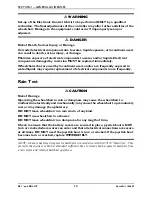
SECTION 4—SAFETY/HANDLING OF WHEELCHAIRS
R51™and R51LXP
22
Part No. 1106645
A Note to Wheelchair Assistants
When assistance to the wheelchair user is required, remember to use good body
mechanics. Keep your back straight and bend your knees whenever tilting wheelchair or
traversing curbs, or other impediments.
WARNING
DO NOT attempt to lift the wheelchair by any removable (detachable) parts. Lift-
ing by means of any removable (detachable) parts of a wheelchair may result in
injury to the user or damage to the wheelchair.
Also, be aware of detachable parts such as arms or leg-rests. These must NEVER be used
for hand-hold or lifting supports, as they may be inadvertently released, resulting in
possible injury to the user and/or assistant(s).
When learning a new assistance technique, have an experienced assistant help you before
attempting it alone.
Tilting
WARNING
DO NOT tilt the wheelchair without assistance.
When tilting the wheelchair, an assistant should grasp the back of the wheelchair on a
non-removable (non-detachable) part. Inform the wheelchair occupant before tilting the
wheelchair and remind him/her to lean back. Be sure the occupant’s feet and hands are
clear of all wheels.
Tilting - Curbs
After mastering the techniques of tilting the wheelchair, use this procedure to tackle
curbs, short stairs, etc.
This procedure requires two assistants. The second assistant should be positioned at the
front of the wheelchair lifting upward on a non-removable (non-detachable) part of the
wheelchair frame when lifting the wheelchair and stabilizing the wheelchair when the
wheelchair is being lowered to the ground.
The first assistant should turn the anti-tippers so the wheels are pointing up, apply a
continuous downward motion until the balance point is achieved and the front casters
clear the curb. At this point, the assistants will feel a difference in the weight distribution.
















































